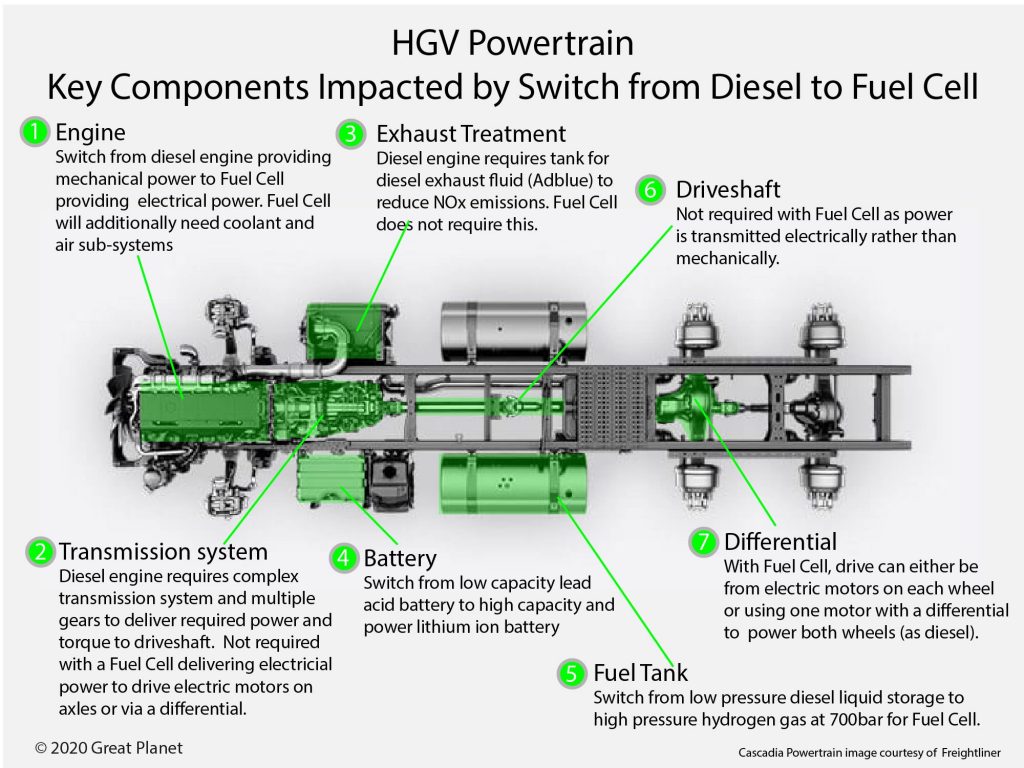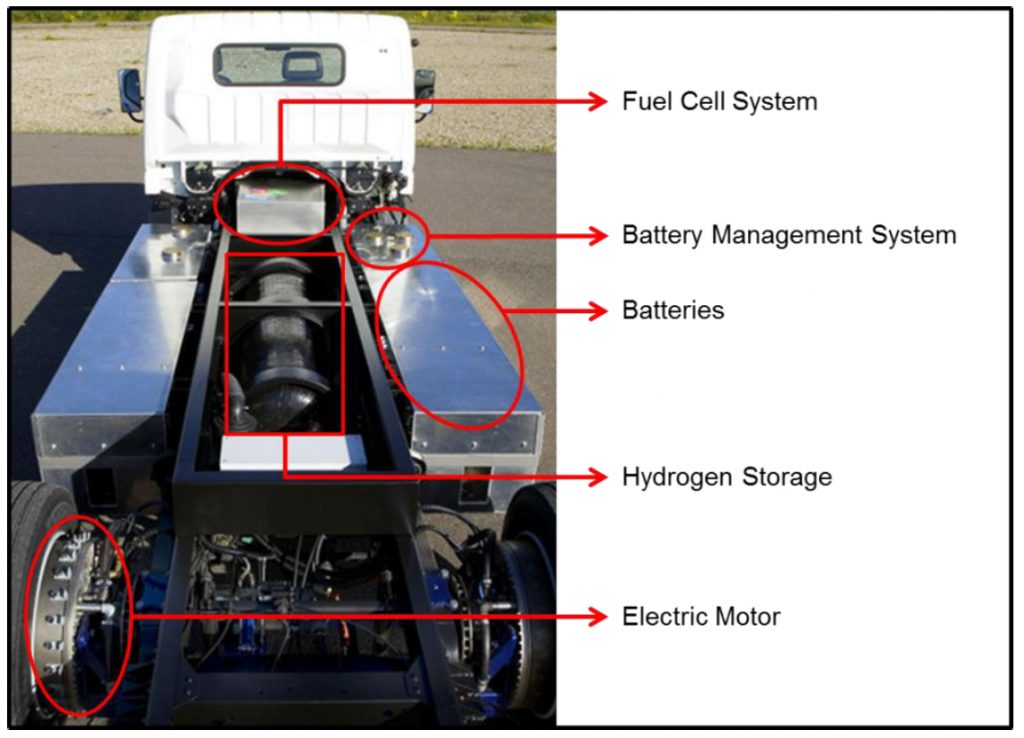This is part 3 of a seven part series which explores some of the issues around zero carbon vehicles and which future technologies might be best for HGVs to avoid carbon emissions. The seven parts are:
- Understanding the Typical Power Requirements of an HGV
- Basic Designs of Diesel, Battery and Fuel Cell Powertrains
- Comparing Diesel, Battery and Fuel Cell Powertrains (this post)
- Assessing Future Manufacturing Costs of Diesel, Battery and Fuel Cell Powertrains for HGVs
- Costs of Hydrogen Fuel / Building A Hydrogen & Electric Charging Infrastructure
- Commercial Viability of Operating A Battery or Fuel Cell Powertrain HGV
- Summary, A Look at Developments Which May Help Achievement of Zero Carbon In-use HGVs.
Part 3: Comparison of Diesel, Battery and Fuel Cell Powertrains
In Part 3 we compare diesel, electric battery and hydrogen fuel cell powertrains for Heavy Goods Vehicles (HGVs).
3.1 Driving Range and Refuelling Time
Figure 8 shows the total weight of the fuel/storage required for diesel, hydrogen fuel cell or electric battery powered trucks delivering the same range as a diesel truck using 379 litres of diesel (a standard 100 US gallon diesel fuel tank). The indicative driving range for each truck would be 910 km, putting the truck in the longhaul classification for daily driving range.

Assumes 164 Wh/kg for battery energy density
From a fuel weight and refuelling perspective, diesel has clear benefits, although their are opportunities for fuel cell/battery vehicles to reduce weight on other powertrain components (see later) and work is going on to reduce hydrogen storage and battery weights. Refuelling time is particularly important for commercial drivers which is why fuel companies often provide pumps with faster fuel dispensing for HGVs.
With a hydrogen fuel cell, whilst only 68kg of fuel is needed this is stored at 700 bar pressure, which requires very heavy composite storage tanks (assuming 5.7% gravimetric capacity). Not included in this weight calculation is the additional weight of any battery storage used with a fuel cell vehicle, as this will vary depending on the design from as little as 100kg to over 1,000kg (looked at later in this post).
Existing fuel dispenser delivery rates for hydrogen cars and buses are of the order of 120kg/hour meaning that filling an empty HGV hydrogen tank will take around 35 minutes, including the time to connect/disconnect the hydrogen dispenser to the vehicle. In March 2019 a cross-industry group of hydrogen infrastructure companies and fuel cell electric vehicle manufacturers signed a MOU (Memorandum of Understanding) for hydrogen fueling components: “The aim is to test state-of-the-art heavy-duty (HD) hydrogen fueling hardware to assist in standardisation and quickly bringing fuel cell powered trucks to market” (Science Direct 2019). Two of the MOU signatories, Shell and Toyota, are collaborating on the development of the first hydrogen-truck refueling station at the Port of Long Beach (Shell 2018). In addition, ISO/TC 197, the technical committee responsible for developing international standards on hydrogen energy technologies, is looking at high flow 700 bar Heavy Duty Fueling protocols and Hardware. According to Nikola this will allow refuelling rates of circa 320kg/hour meaning that 60kg H2 can be dispensed in around 12 minutes (Nikola 2020). A Nikola pilot station for Heavy Duty hydrogen dispensing is planned for Q3 2021 in Phoenix, AZ.
For battery electric vehicles (BEVs) battery weight for energy storage is a major consideration. Losing a few tonnes of freight from an HGV just to accommodate the increased battery weight is not something a commercial operator would be keen on, so improving battery energy density would be an important element of developing battery powered HGVs.
Future Battery Energy Density Improvements
An energy density of 164 Wh/kg is assumed for the battery storage pack , based on a recent product tear down of the Tesla Model 3 battery pack. It is helpful to differentiate between claims for battery cell, battery module and battery pack energy densities. A battery cell is the component which stores energy. These are generally built into modules or assemblies to hold a number of cells in a frame, which adds weight but no storage capacity. A number of modules are built into the battery pack which is designed to provide structural support, provide cooling and freeze protection and a battery management system, all again adding weight but no extra capacity. Whilst you will see claims for higher energy densities these are often for the battery cell itself, not the complete battery pack. More recent work at the Lawrence Berkeley National Laboratory on battery weight assumes a 250 Wh/kg cell energy with a packing fraction of 0.88 which would lead to a 220Wh/kg storage pack. The Battery 500 consortium are initiating research to deliver battery packs with 500 Wh/kg, although no specific timescale is indicated. Both these developments would start to close the weight gap with diesel.
Recharging 1,131 kWh of batteries with a 120 kW supercharger would take over 9 hours, although Tesla are anecdotally reported to be exploring splitting battery packs for their under-development “Semi” truck into four separately chargeable segments for the “Semi” which would bring the recharge time down to under 2 hours but require use of four chargers at once. Even two hours is not an attractive fuelling time for a commercial truck operator.
When considering refuelling, one aspect that is worth further consideration is how easily can technological solutions be applied across the world to replace diesel. There is little point in providing HGV zero carbon solutions for developed nations such as the UK if they can not also be used in developing countries, where the electricity infrastructure for charging may be severely limited.
3.2 Powertrain Weight Difference (including fuel/storage)
The switch from a diesel to a battery/fuel cell powertrain means significant changes to componentry which gives scope for weight reduction on non-fuel related components. Figure 9 shows some of the changes for a switch from diesel to fuel cell, with the diesel engine, transmission and driveshaft no longer required. Diesel fuel tanks are swapped for battery or fuel cell components. A key area of development is electric motors to either power individual wheels or a complete axle, ideally using regenerative braking so electricity can be generated when the vehicle is slowing down.

Figures 10 & 11 shows two estimates of different Powertrain weights with fuel and storage built in. The weight comparison ignores common elements such as axles, which would potentially be used on all drivetrains. There may be scope for further “lightweighting” of these components if they are not used for power transmission. Figure 10 uses the 164 Wh/kg proven density of the Tesla battery whereas Figure 11 assumes 220 Wh/kg pack density is achievable.

Assumes 164 Wh/kg for battery energy density

Assumes 220 Wh/kg for battery energy density
Two different fuel cell example designs have been included in the comparison, to show that their are different design choices:
- Fuel cell with 12 kWh battery storage: A small amount of battery storage is usually for a design that is fuel cell dominant, where the fuel cell output follows power demand changes and the battery is used for short term supply of peak power and to store energy from regenerative braking. Running a fuel cell in this way means it has to be responsive to demand changes and may not always operate at optimum efficiency. It would be lighter than the diesel equivalent.
- Fuel cell with 240 kWh battery storage: This is likely to be a battery dominant design where the battery is used to supply instantaneous power and the fuel cell runs smoothly in the battery to top up the battery when required. It can be left to run at optimum efficiency. This type of design could also be described as a battery range extended as the vehicle effectively runs on battery all the time.
There is clearly work to be done on both fuel cell and battery technology to further reduce overall powertrain weight. Progress on drivetrain “lightweighting” and battery weight reduction would benefit both fuel cell and battery powered HGVs, depending on the battery capacity chosen. The battery electric vehicle could be reduce in weight by reducing storage capacity and sacrificing driving range ie. if the 220 Wh/kg energy density could be achieved and the vehicle range was reduced to 455 km rather than 910km then the BEV weight could be in line with diesel. A greater emphasis would then need to be placed on speed of charging.
3.3 Powertrain Volume Differences
With a different set of componentry for hydrogen fuel cell and battery electric vehicles compared to diesel HGVs it is not a precise assessment but it is likely that:
- A fuel cell will require circa 0.7-2.7m3 more than a diesel powertrain, depending on hydrogen storage density at 700 bar
- A battery electric vehicle at a 500Wh/litre density would require a similar volume to a diesel engine (approx 2 m3 ), although the weight balance would need to be considered with an extra 2-4 tonne of weight (depending on energy density).
For the hydrogen fuel cell design, two basic options have been identified which are shown in Figures 12 & 13 below. For safety reasons, fuel cell truck designers do not put the hydrogen storage tanks under the driver’s cab. Designs from Vision Industries Corporation (Figure 12) show hydrogen storage cylinders mounted behind the tractor unit driver’s cab. Vision Industries filed for bankruptcy in December 2014. The rigid truck design (Figure 13) shows storage mounted below the load area rather than behind the cab area. This avoids increasing the length of the overall vehicle and also keeps visibility through the rear-view mirror. For tractor units with trailers this design could be mirrored by using the trailer chassis, although this would require special trailers to be designed.


Part 4 will assess future manufacturing costs of diesel, battery and fuel cell powertrains for HGVs.
References
Nikola (2020). Presentation by Jesse Schneider on Clean Fuel for Zero Emission Trucks [online]. Available at: https://www.hydrogen.energy.gov/pdfs/htac_nov19_07_schneider.pdf [Accessed 4 February 2020]
Science Direct (2019). Industry group focuses on hydrogen fueling hardware for trucks [online]. Available at: https://www.sciencedirect.com/science/article/pii/S146428591930104X [Accessed 4 February 2020]
Phadke, Khandekar et al (2019). Long-haul battery electric trucks are technically feasible and economically compelling. Working Paper 005, International Energy Analysis Department, Lawrence Berkeley National Laboratory. Available at: https://ies.lbl.gov/publications/working-paper-005-long-haul-battery. [Accessed 14 January 2020]
Shell (2018). HYDROGEN FOR FUEL CELL ELECTRIC VEHICLE AND HEAVY-DUTY TRUCKS [online]. Available at: https://www.shell.us/about-us/features-and-highlights/hydrogen-for-fuel-cell-electric-vehicle-and-heavy-duty-trucks.html [Accessed 4 Fenbruary 2020]

Leave a Reply